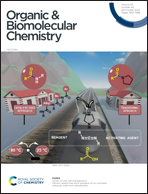Chemoselective, osmium-free, dihydroxylation/oxidative cleavage of heteroaryl isoprenes by a contemporary Malaprade reaction†‡
Abstract
The methyl ketone is a central synthetic building block for the construction of advanced heteroaryl scaffolds and systems. Reactions, including oxidative cyclization strategies, are often predicated on efficient access to this ubiquitous moiety. In the context of arenes, standard approaches leveraging Markovnikov hydration/oxidation or oxidative cleavage of the C–C π bond often afford satisfactory performance. However, when the substrate contains an electron-deficient heteroaryl core, the traditional Malaprade reaction, and related oxidative-cleavage strategies, frequently result in diminished performance over carbon-based arenes. In this work we present the development and application of an oxidative cleavage reaction of various pyridinyl isoprenes towards accessing the downstream methyl ketone for utilization in advanced cyclizations for the preparation of soft-N-donor complexant scaffolds. This efficient protocol parallels the principles of Green chemistry by exchanging KMnO4 for the toxic OsO4 and offers the end-user an efficient, more environmentally friendly option for accessing heteroaryl methyl ketones in one hour of reaction time using potassium permanganate and sodium paraperiodate as a synergistically potent oxidative cleavage system. The wide substrate scope defined access to simple, as well as advanced heteroaryl methyl ketones. Method development, optimization, substrate scope, preliminary mechanistic observations, and a scale up reaction are delineated herein.



 Please wait while we load your content...
Please wait while we load your content...
